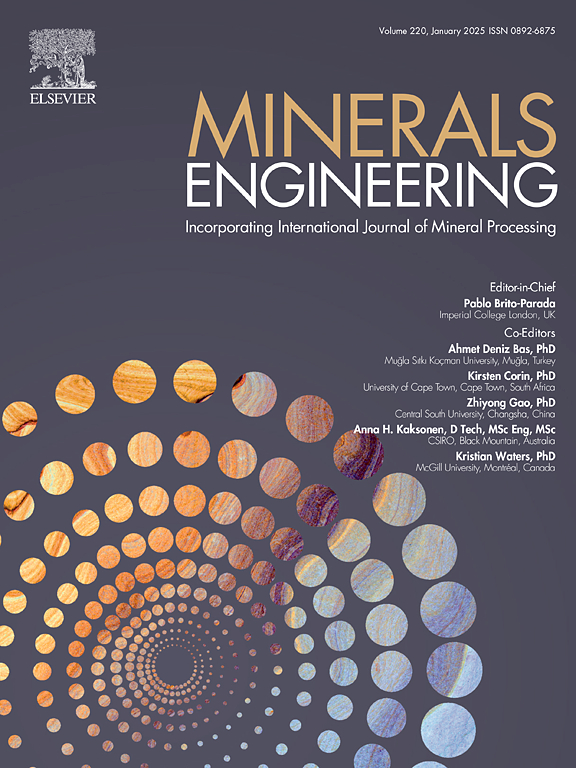The combined inhibitory effect of potassium permanganate and modified polyacrylamide on the flotation behavior of antimonite and arsenopyrite
IF 4.9
2区 工程技术
Q1 ENGINEERING, CHEMICAL
引用次数: 0
Abstract
The selective separation of antimonite and arsenopyrite minerals is both a critical and challenging task. This study investigated the combined inhibitory effects of two new reagents on the flotation behaviour of these minerals under low-alkalinity conditions. The inhibitory effects and adsorption mechanisms of these reagents were systematically studied through microflotation and mixed ore flotation experiments, X-ray photoelectron spectroscopy (XPS) energy spectrum analysis, contact angle testing, scanning electron microscopy-energy dispersive X-ray (SEM–EDS) analysis, phase diagram analysis, and first-principles calculations. The flotation results showed that the combined use of potassium permanganate and modified polyacrylamide produced a stronger inhibitory effect on arsenopyrite compared to their individual effects. Using potassium permanganate and modified polyacrylamide as the inhibitor system and butylamine black as the collector at pH 9, the recovery rates of antimony ore and arsenopyrite differed by more than 80 %. XPS measurements indicated that potassium permanganate caused severe oxidation of arsenopyrite surfaces, forming iron oxide/hydroxide, which facilitated the adsorption of modified polyacrylamide. Contact angle measurements showed that potassium permanganate rendered arsenopyrite surfaces more hydrophilic, whereas modified polyacrylamide increased the difference between the surfaces of antimonite and arsenopyrite. SEM–EDS testing analysed the oxidation degree and identified oxidation products on arsenopyrite surfaces, which were validated through phase diagram analysis. First-principles calculations revealed the adsorption inhibition mechanism of the reagents on the arsenopyrite surface.
选择性分离锑矿和砷黄铁矿矿物既是一项关键任务,也是一项具有挑战性的任务。本研究调查了两种新试剂在低碱度条件下对这些矿物浮选行为的综合抑制作用。通过微浮选和混合矿浮选实验、X 射线光电子能谱(XPS)分析、接触角测试、扫描电子显微镜-能量色散 X 射线(SEM-EDS)分析、相图分析和第一原理计算,系统研究了这些试剂的抑制作用和吸附机理。浮选结果表明,联合使用高锰酸钾和改性聚丙烯酰胺对黄铜矿的抑制作用比单独使用时更强。在 pH 值为 9 的条件下,以高锰酸钾和改性聚丙烯酰胺作为抑制剂系统,以丁基胺黑作为捕收剂,锑矿和砷黄铁矿的回收率相差 80% 以上。XPS 测量结果表明,高锰酸钾导致砷黄铁矿表面严重氧化,形成氧化铁/氢氧化物,从而促进了改性聚丙烯酰胺的吸附。接触角测量显示,高锰酸钾使黄铜砷矿表面更亲水,而改性聚丙烯酰胺则增加了锑矿和黄铜砷矿表面之间的差异。SEM-EDS 测试分析了氧化程度,确定了砷黄铁矿表面的氧化产物,并通过相图分析进行了验证。第一原理计算揭示了试剂在砷黄铁矿表面的吸附抑制机制。
本文章由计算机程序翻译,如有差异,请以英文原文为准。
求助全文
约1分钟内获得全文
求助全文
来源期刊

Minerals Engineering
工程技术-工程:化工
CiteScore
8.70
自引率
18.80%
发文量
519
审稿时长
81 days
期刊介绍:
The purpose of the journal is to provide for the rapid publication of topical papers featuring the latest developments in the allied fields of mineral processing and extractive metallurgy. Its wide ranging coverage of research and practical (operating) topics includes physical separation methods, such as comminution, flotation concentration and dewatering, chemical methods such as bio-, hydro-, and electro-metallurgy, analytical techniques, process control, simulation and instrumentation, and mineralogical aspects of processing. Environmental issues, particularly those pertaining to sustainable development, will also be strongly covered.
 求助内容:
求助内容: 应助结果提醒方式:
应助结果提醒方式:


